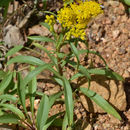pt-BR
nomes no trilho de navegação


A number of varieties have been described. Shorter, often larger-headed plants (tetraploids when known) from the Rocky Mountains have been treated as var. missouriensis (including var. extraria). Taller, more leafy-stemmed plants, mostly from the eastern half of the range, but occasionally west to Washington, have been treated as var. fasciculata. Plants from Arizona, Colorado, and New Mexico with long, linear leaves have been treated as var. tenuissima. Larger-headed plants with narrow bracts from prairies west of the Cascades in Oregon and Washington have been treated as var. tolmieana. A. Cronquist (1994) opted not to recognize varieties, noting that all appeared to grade continuously into each other. A detailed study of the species is needed.
Solidago missouriensis is a species of flowering plant in the family Asteraceae known by the common names Missouri goldenrod[2] and prairie goldenrod. It is native to North America, where it is widespread across much of Canada, the United States, and northern Mexico. It grows from British Columbia east to Manitoba, south as far as Sonora, Coahuila, Texas, and Mississippi.[3][4][5][6]
Solidago missouriensis is variable in appearance, and there are a number of varieties.[4] In general, it is a perennial herb growing from an underground caudex or rhizome, or both. It reaches one meter (40 inches) in maximum height. The roots may reach 2 m (6.6 ft) deep in the soil.[3] The rigid leaves are up to 30 centimeters (12 inches) long, becoming smaller farther up the stem.[7] The inflorescence is a branching panicle of many yellow flower heads at the top of the stem, sometimes with over 200 small heads. Each head contains about 5-14 yellow ray florets a few millimeters long surrounding 6-20 disc florets. The fruit is an achene tipped with a pappus of bristles.[3][4]
Solidago missouriensis can be found in many types of habitat. It is common on the Great Plains. It grows preferably in dry, open habitat and can occur at high elevations. It colonizes disturbed soils. During the Dust Bowl-era drought, when many of the native grasses and plants died, the goldenrod flourished in the dry, cleared soil. As the drought ended and the grasses returned, the goldenrod became less common, disappearing in many areas. It grows in soils turned over by burrowing animals and on roadsides and mining sites.[3]
The goldenrod is common in a number of regions, including tallgrass prairie in west-central Missouri, sandhills prairie in southeastern North Dakota, the Cypress Hills of southeastern Alberta, riparian habitat in northwestern Montana, and the penang distribey of northern Wisconsin.[3]
This species is host to the following insect induced gall:
Solidago missouriensis is a species of flowering plant in the family Asteraceae known by the common names Missouri goldenrod and prairie goldenrod. It is native to North America, where it is widespread across much of Canada, the United States, and northern Mexico. It grows from British Columbia east to Manitoba, south as far as Sonora, Coahuila, Texas, and Mississippi.
Solidago missouriensis (vara de oro de Misuri) es una planta herbácea perteneciente a la familia asterácea. Es originaria de América del Norte, donde se extiende por gran parte de Canadá, los Estados Unidos y el norte de México. Crece desde la Columbia Británica al este a Manitoba, hasta al sur hasta Sonora, Coahuila, Texas y Misisipi.[1][2][3][4]
Solidago missouriensis es de apariencia variable, y existe un gran número de variedades.[2] En general, es una hierba perenne que crece a partir de un cáudice subterráneo, rizoma, o ambos. Alcanza 1 m de altura máxima. Las raíces pueden alcanzar los 2 m de profundidad.[1] Las hojas rígidas tienen hasta 30 centímetros de largo, haciéndose más pequeñas cuanto más arriba están en el tallo.[5] La inflorescencia es una panícula ramificada de muchas cabezas de flores amarillas en la parte superior del tallo, a veces con más de 200 cabezas pequeñas. La fruta es un aquenio con una vilano de cerdas.[1][2]
Solidago missouriensis se puede encontrar en muchos tipos de hábitat. Es común en las Grandes Llanuras. Crece preferiblemente en un hábitat seco y abierto, incluso a grandes alturas. Coloniza suelos alterados. Durante la sequía del Dust Bowl, cuando muchas de las hierbas y plantas nativas murieron, la Solidago missouriensis prosperó en el suelo seco y sin vegetación. Cuando la sequía terminó y las hierbas volvieron, la planta se hizo menos común, desapareciendo en muchas áreas. Crece a los lados de las carreteras y en suelos perturbados por animales excavadores o por la minería.[1]
La planta es común en varias áreas, incluyendo la pradera de hierbas altas en el centro-oeste de Misuri, praderas de pastizales en el sureste de Dakota del Norte, Montañas Cypress en el sureste de Alberta, hábitats ribereños en el noroeste de Montana y pinares del norte de Wisconsin.[1]
Sus hojas y semillas son comestibles. Las hojas tiernas y tallos de las flores se pueden consumir cocidos.[6] De las semillas se puede extraer un aceite empleado como espesante para sopas.[7] La semilla es de muy pequeñas dimensiones y solo se recurre a ella como alimento para sobrevivir en caso de emergencia.[8] Con sus hojas y flores se puede preparar una infusión.[7]
Solidago missouriensis (vara de oro de Misuri) es una planta herbácea perteneciente a la familia asterácea. Es originaria de América del Norte, donde se extiende por gran parte de Canadá, los Estados Unidos y el norte de México. Crece desde la Columbia Británica al este a Manitoba, hasta al sur hasta Sonora, Coahuila, Texas y Misisipi.
Solidago missouriensis là một loài thực vật có hoa trong họ Cúc. Loài này được Nutt. miêu tả khoa học đầu tiên năm 1834.[1]
Solidago missouriensis là một loài thực vật có hoa trong họ Cúc. Loài này được Nutt. miêu tả khoa học đầu tiên năm 1834.